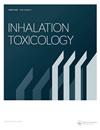Co-exposure of peptidoglycan and heat-inactivated Asian sand dust exacerbates ovalbumin-induced allergic airway inflammation in mice
IF 2
4区 医学
Q4 TOXICOLOGY
引用次数: 0
Abstract
Abstract Aims Asian sand dust (ASD) comprises soil particles, microorganisms, and various chemical components. We examined whether peptidoglycan (PGN), a structural cell wall component of Gram-positive bacteria, exacerbates ASD-induced allergic airway inflammation in mice. Methods The ASD (median diameter ∼4 µm) used was a certified reference material from the National Institute for Environmental Studies in Japan, derived from Gobi Desert surface soil collected in 2011. BALB/c mice were intratracheally exposed to PGN, heat-inactivated ASD (H-ASD), and ovalbumin (OVA), individually and in combination. Twenty-four hours after the final intratracheal administration, bronchoalveolar lavage fluid (BALF) and serum samples were collected. Inflammatory cell count, cytokine levels in the BALF, OVA-specific immunoglobulin levels in the serum, and pathological changes in the lungs were analyzed. Results and Discussion After OVA + PGN + H-ASD treatment, the number of eosinophils, neutrophils, and macrophages in the BALF and of eosinophils in the lung tissue was significantly higher than that after OVA + PGN or OVA + H-ASD treatment. Moreover, levels of chemokines and cytokines associated with eosinophil recruitment and activation were significantly higher in the BALF of this group than in that of the OVA + PGN group, and tended to be higher than those in the OVA + H-ASD group. Pathological changes in the lungs were most severe in mice treated with OVA + PGN + H-ASD. Conclusions Our results indicate that PGN is involved in the exacerbation of ASD-induced allergic airway inflammation in mice. Thus, inhalation of ASD containing Gram-positive bacteria may trigger allergic bronchial asthma.肽聚糖和热灭活的亚洲沙尘的共同暴露加剧了卵清蛋白诱导的小鼠过敏性气道炎症
摘要目的亚洲沙尘由土壤颗粒、微生物和各种化学成分组成。我们检测了肽聚糖(PGN),一种革兰氏阳性菌的结构细胞壁成分,是否会加剧ASD诱导的小鼠过敏性气道炎症。方法ASD(中径~4 µm)是日本国家环境研究所的认证参考物质,来源于2011年收集的戈壁滩表层土壤。BALB/c小鼠气管内暴露于PGN、热灭活ASD(H-ASD)和卵清蛋白(OVA),单独或组合。最后一次气管内给药24小时后,采集支气管肺泡灌洗液(BALF)和血清样本。分析炎症细胞计数、BALF中的细胞因子水平、血清中OVA特异性免疫球蛋白水平和肺部的病理变化。OVA后的结果和讨论 + PGN + H-ASD治疗后,BALF中嗜酸性粒细胞、中性粒细胞和巨噬细胞的数量以及肺组织中嗜酸性细胞的数量显著高于OVA治疗后 + PGN或OVA + H-ASD治疗。此外,与嗜酸性粒细胞募集和活化相关的趋化因子和细胞因子水平在该组的BALF中显著高于OVA + PGN组,并且往往高于OVA组 + H-ASD组。OVA治疗的小鼠肺部病理变化最为严重 + PGN + H-ASD。结论PGN参与了ASD诱导的小鼠过敏性气道炎症的加重。因此,吸入含有革兰氏阳性菌的ASD可能引发过敏性支气管哮喘。
本文章由计算机程序翻译,如有差异,请以英文原文为准。
求助全文
约1分钟内获得全文
求助全文
来源期刊

Inhalation Toxicology
医学-毒理学
CiteScore
4.10
自引率
4.80%
发文量
38
审稿时长
6-12 weeks
期刊介绍:
Inhalation Toxicology is a peer-reviewed publication providing a key forum for the latest accomplishments and advancements in concepts, approaches, and procedures presently being used to evaluate the health risk associated with airborne chemicals.
The journal publishes original research, reviews, symposia, and workshop topics involving the respiratory system’s functions in health and disease, the pathogenesis and mechanism of injury, the extrapolation of animal data to humans, the effects of inhaled substances on extra-pulmonary systems, as well as reliable and innovative models for predicting human disease.
 求助内容:
求助内容: 应助结果提醒方式:
应助结果提醒方式:


